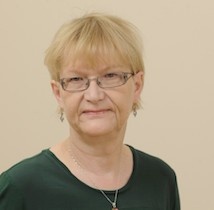Paivi Torkkeli
Professor

Email: paivi.torkkeli@dal.ca
Phone: 902-494-2672
Mailing Address:
3C, Tupper Building, 5580 College Street, PO Box 15000, Halifax, Nova Scotia, Canada, B3H 4R2
Research Topics:- Neuroscience
- Sensory physiology
- Synaptic physiology
- Mechanotransduction
- Olfaction
- Vision
- Ion channel
- Neurotransmitters
Education
- BSc (University of Oulu, Finland)
- MSc (University of Oulu, Finland)
- Licentiate of Science (University of Oulu, Finland)
- PhD (University of Alberta)
Research interests
Our research focuses on molecular and cellular mechanisms of mechanosensory transduction. We aim to discover molecules that detect mechanical stimuli and to learn how sensory signals are modulateed by synapses and transmitted to the CNS. We also work on vision and olfaction. We use a variety of advanced biophysical, electrophysiological, imaging and molecular techniques.
Selected publications
- Frolov R.V, Severine I., Novikova E., Ignatova I.I, Liu H., Torkkeli P.H, & French A.S 2022: Opsin knockdown specifically slows phototransduction in broadband and UV-sensitive photoreceptors in Periplaneta americana J. Comp Physiol A 208:591-604.
- Johnson J.A.G., Liu H., Höger U., Rogers S.M., Sivapalan K., French A.S. & Torkkeli P.H. 2021: Mechanotransduction channel Piezo is widely expressed in the spider, Cupiennius salei, mechanosensory neurons and central nervous system Scientific reports 11(1):7994. doi.org/10.1038/s41598-021-87202-1 //rdcu.be/ciwNW
- Hennenfent A., Liu H., Torkkeli P.H. & French A.S 2020: RNA interference supports a role for Nanchung-Inactive in mechanotransduction by the cockroach, Periplaneta americana tactile spine. Invert. Neurosci. doi:20(1): 10.1007/s10158-019-0234-x
- Sukumar V., Liu H., Meisner S., French A.S. & Torkkeli P.H. 2018: Multiple biogenic amine receptor types modulate spider, Cupiennius salei, mechanosensory neurons. Front. Physiol. 9:857. doi: 10.3389/fphys.2018.00857
- Fabian-Fine R., Anderson C., Roush M., Johnson, J.A.G. Liu H., French A.S. & Torkkeli P.H. 2017: The distribution of cholinergic neurons, and their co-localization with FMRFamide in central and peripheral neurons of the spider Cupiennius salei. Cell Tissue Res. 370:71-88.
- Liu H., French A.S & Torkkeli P.H. 2017: Expression of Cys-loop receptor subunits and acetylcholine binding protein in the mechanosensory neurons, glial cells and muscle of the spider Cupiennius salei. J. Comp. Neurol. 525:1139-1154.
